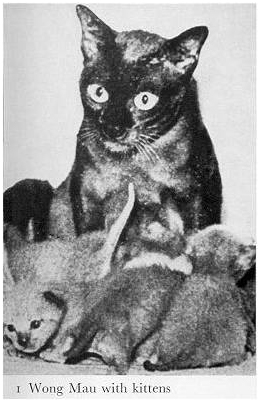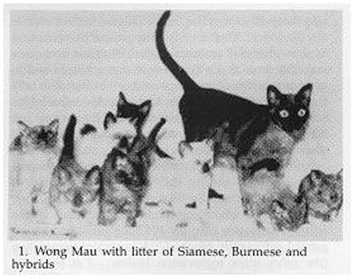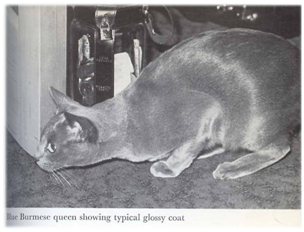About the breed

The history of the Burmese breed began in 1930, when Dr. Joseph Thompson brought an unusual cat Wong Mau to the USA, San Francisco from Burma, its western coast
This cat surprised him with its unusual appearance, so much different from the well-known breeds. Especially unique was its amazing color - reddish-brown, walnut - later called Burmese sepia.
The following description of Wong Mau has been preserved: "a fairly small cat, thin-boned, but with a more compact body compared to a Siamese cat, with a shorter tail, with a rounded head and a short muzzle, with a wider distance between rounded eyes"
Of all possible partners, a Siamese Tai Mau cat of the seal point color was chosen for mating Wong Mau as the closest in phenotype. It should be noted that in the 30s of the 20th century, Siam looked different. Over the years of breeding, the Siamese breed has changed the most, both in terms of body type and head type.
Two types of kittens were born in the litter: Siamese color and a color similar to mom. Dark brown kittens were carefully selected and used in further breeding programs.
Dr. Thompson and a group of scientists from the University of California, led by Dr. Keller, and a group of enthusiasts from the local felinological society with extensive experience in breeding cats conducted competent breeding work and were able to identify the distinctive breed characteristics of Wong Mau and consolidate them in the offspring.
The preliminary standard of the Burmese breed was presented already in 1934. And in 1936 he was accepted.

Early Burmese in the late 30s - early 40s quickly gained popularity. There was a huge demand for kittens. Breeders continued to use Siamese cats to increase the very limited number of breeding animals, thus obtaining a large number of hybrids. Because of this, in 1947, the CFA suspended the registration of Burmese. And decided on the need for at least three generations of purebred Burmese to register a cat as a Burmese. For many, this has become a challenge. But, nevertheless, serious breeders did not stop working and, already in 1957, the CFA resumed registration, taking into account a sufficient number of purebred animals.
Later, already in the 60s and 70s of the XX century, other aboriginal Burmese were imported to the United States. However, most of us still proudly trace our ancestry back to Wong Mau.

In 1958, the Burmese Cat Lovers Club (UBCF) began developing a Burmese cat standard that would be recognized by all cat lovers organizations. This standard was adopted by the CFA in 1959, it was also approved by other felinological associations and has remained largely unchanged since then. Quoting this original standard: "The head should be pleasantly rounded, without flat surfaces both when viewed from the front and from the side. The muzzle should be full, with a significant distance between the eyes, slightly narrowing to a short, well-developed muzzle. The body had to be medium-sized, muscular, compact, with a wide rounded chest.
The black color of Burmese cats was the first officially registered color of this breed. The first standard of black color of Burmese cats was adopted by the CFA. It was named sable (Sable-sable) for its similarity to the luxurious iridescent sable fur.
But whether introduced by initial mating with Siamese, which were necessary to create the breed, whether originally existing, lighter-colored kittens appeared from time to time in Burmese litters. Early breeders made a conscious decision during the creation of the breed: they preferred cats with dark, sable hair and tried to get rid of lighter colors as well as more pronounced points. And indeed, the glossy and shining coat, deep sable color, shimmering on the strong muscles of the Burmese cat is wonderfully good. However, no matter how hard they tried to avoid them, lighter colors - chocolate, blue, purple continued to be split in litters.
The clarified colors in Burmese are similar to the spectrum of colors of Siamese cats - Burmese have a weakening of both blue and chocolate type. Cats without the gene of weakened color are painted in the traditional sable-brown Burmese color. The blue weakening in itself gives a coat of moderate blueness with a warm dark yellow shade - the Burmese blue color is not cold at all. Chocolate attenuation gives a warm honey-beige color, which in Burmese is called champagne, while both attenuating genes give a fawn, silver-gray with a yellowish-brown tinge of color, called platinum.
In 1979, the CFA decided to separate Burmese cats of blue, purple and chocolate colors into a separate breed, which was called Malayan (Malayans). This breed existed in the CFA until 1984, when Malay cats were reunited with Burmese cats, creating a special division of clarified colors of Burmese cats (Burmese Dilutes) for this purpose
In 2010, the dilute division was abolished — now in CFA, as in other systems, Burmese belong to a common, solid division.
European branch:

In 1949, Lilian Fnans of Derby took three Burmese cats to England. The new breed immediately attracted the attention of breeders and enthusiasts. In 1955, The Burmese Cat Club was established in England, and in 1979 - The Burmese Cat Society (The Burmese Cat Society). To increase the number of the breed, breeders continued to use Siamese cats that had a slightly different appearance than those that were attracted for this purpose — it was already a modern type of Siamese cats with refined lines and proportions, thinner bones and a long head. As a result, the appearance of Burmese cats bred in England and other European countries began to differ from the appearance of American Burmese cats.
In 1952, the two largest associations of cat lovers in England, GCCF and CA, adopted standards for Burmese cats that differ in their requirements from the first standard approved by the CFA.
There are two directions in the breeding of the Burmese breed: the appearance of the American and European Burmese cats differ so much that the European version is singled out as a separate breed, which gets the name of the European Burmese cat — European Burmese. Crosses of European and American Burmese are prohibited.

In 1955, in England, an ordinary brown Burmese cat Golden Gate Puppies (Chinki GoldenGay) unexpectedly gave birth to a very light kitten, which was named Blue Surprise. It really was a surprise for geneticists, as the cat gave birth to brown and light kittens. Soon, as a result of breeding work in the UK, burmese of light brown color appeared, and then light blue.
Geneticists were satisfied with the result, but they wanted more: to get red, cream and tortoiseshell burmese. However, they understood that for this it would be necessary to cross the Burmese with another breed carrying the red gene, so it was tied with the Siamese cat red point, and by 1977 six more colors were obtained in the UK.
But American felinologists did not share the joy of the English. In their opinion, the English colleagues were too "carried away" with the breeding of new colors, the breed began to lose the main, in their opinion, the external distinguishing feature of roundness of forms - and refused to accept innovations. In turn, European felinologists established their own standard of the Burmese breed, where there was no such emphasis on roundness: the legs had to be thin, elegant and long, the upper eyelid of the eye was straight. Burmese were allowed ten colors.

After the separation, both types continued to develop, but each in its own way. The Americans have raised the image of the "round" Burmese to a cult. To achieve maximum extremity, the blood of exotics and Persians began to be mixed with this breed, which eventually led to the isolation of another type of American Burmese – extreme. The European burmese, on the other hand, thinned and became lighter, approaching the Siamese cats in body structure.
(Source: russianburmese.com )













